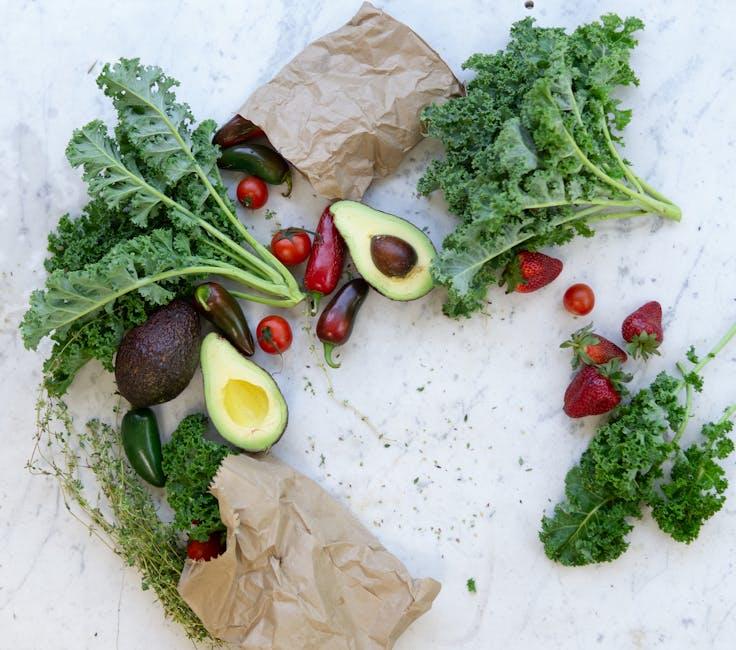In the world of keto cuisine, vegetables often play the quiet yet essential role of nutrient-packed sidekicks—low in carbs but high in flavor and vitality. Navigating the lush landscape of produce can be a challenge when every gram of carbohydrate counts, but fear not: there’s a vibrant variety of low-carb vegetables perfectly suited to fuel your ketogenic lifestyle. From crisp greens to vibrant roots, these humble heroes bring texture, color, and nourishment to your plate without tipping the carb scales. Join us as we explore the best low-carb vegetables that seamlessly blend with the keto mindset, proving that eating green can be both delicious and ketogenic-friendly.
Best Low-Carb Vegetables to Incorporate into Your Keto Diet
When selecting vegetables for a keto lifestyle, focus on those that are not only low in carbs but also rich in fiber, vitamins, and antioxidants. Non-starchy options like leafy greens, broccoli, and cauliflower deliver robust nutrition without kicking you out of ketosis. Among the favorites are spinach, zucchini, and asparagus, which provide vital micronutrients while keeping your carb intake in check. Incorporating these into salads, sautés, or even spiralized noodle alternatives can diversify your meals without compromising keto goals.
For a quick glance at some top contenders, the following list highlights low-carb vegetables to easily add bulk and flavor to your dishes:
- Kale – loaded with vitamins A, C, and K
- Brussels Sprouts – crunchy and nutrient dense
- Bell Peppers – vibrant colors with minimal carbs
- Cucumber – hydrating and crisp, great for snacks
- Green Beans – versatile for soups or stir-fries
| Vegetable | Net Carbs (per 100g) | Key Benefit |
|---|---|---|
| Cauliflower | 3g | Great rice substitute |
| Spinach | 1g | High in iron |
| Zucchini | 2g | Perfect for noodles |
| Broccoli | 4g | Rich in fiber |
Nutritional Benefits of Keto-Friendly Vegetables
Incorporating keto-friendly vegetables into your diet unlocks a treasure trove of essential nutrients while keeping carbohydrates in check. These vibrant greens and colorful roots are packed with fiber, vitamins, and antioxidants that support overall health and promote digestion. Unlike starchy vegetables, they help maintain stable blood sugar levels—an essential factor for anyone committed to a ketogenic lifestyle. Moreover, these veggies contribute to a feeling of fullness, aiding in appetite control and sustained energy throughout the day.
Beyond their low-carb profile, these vegetables bring an array of micronutrients crucial for cellular function and immune support. Many keto-friendly options offer a significant dose of vitamin C, vitamin K, and potassium, all while enhancing the flavor and texture of your meals. Consider these nutritional highlights:
- Leafy greens: Rich in iron and calcium, perfect for bone health.
- Cruciferous vegetables: Bursting with antioxidants that reduce inflammation.
- Summer squash: Provides hydration and essential B vitamins.
| Vegetable | Net Carbs (per 100g) | Key Nutrients |
|---|---|---|
| Spinach | 1.4g | Iron, Vitamin K, Magnesium |
| Broccoli | 4g | Vitamin C, Fiber, Folate |
| Zucchini | 2.1g | Vitamin C, Potassium, Manganese |
How to Choose Vegetables with Minimal Net Carbs
When selecting vegetables for a low-carb or keto lifestyle, focus on those that provide the most nutrients with the least impact on your daily carb allowance. Net carbs are calculated by subtracting fiber and certain sugar alcohols from total carbs, as these do not significantly raise blood sugar levels. Prioritizing vegetables with high fiber content can help reduce net carbs, making leafy greens, cruciferous veggies, and certain zucchinis perfect candidates. Remember, fresh and raw options generally hold a better nutrient-to-carb ratio compared to canned or cooked varieties, which may have added sugars or water retention that skews carb counts.
Consider the following factors to ease your choice:
- Fiber Content: Higher fiber means lower net carbs, making veggies like spinach and kale keto-friendly staples.
- Serving Size: Smaller portions of starchier vegetables can keep you within your carb limit.
- Preparation Method: Steaming or roasting without sauces helps avoid hidden carbs.
| Vegetable | Total Carbs (g) | Fiber (g) | Net Carbs (g) |
|---|---|---|---|
| Spinach (1 cup) | 1.1 | 0.7 | 0.4 |
| Broccoli (1 cup) | 6 | 2.4 | 3.6 |
| Zucchini (1 cup) | 3.5 | 1 | 2.5 |
| Cauliflower (1 cup) | 5 | 2 | 3 |
Creative Ways to Prepare Low-Carb Veggies for Every Meal
Elevate your daily meals with inventive twists on low-carb vegetables that keep your keto journey exciting. Start your mornings by spiralizing zucchini or cucumber into refreshing “noodles” drizzled with avocado oil and lemon juice, perfect for a crisp and hydrating breakfast bowl. For lunch, transform cauliflower into a colorful “rice” stir-fry, enhanced with diced bell peppers and fresh herbs to add vibrant flavors and textures. Another brilliant idea is roasting Brussels sprouts with a dusting of smoked paprika and a sprinkle of parmesan, yielding a crispy, savory side that pairs beautifully with grilled proteins.
When it comes to dinner, think beyond steaming—try stuffing portobello mushrooms with a blend of sautéed spinach, garlic, and cream cheese for a hearty, satisfying bite. Incorporate a dynamic mix of sautéed kale and garlic oil as an elegant accompaniment, or make a rustic ratatouille with eggplants, zucchini, and tomatoes simmered slowly to intensify their natural sweetness while staying keto-friendly. Below is a quick guide to spice pairings that complement each vegetable, helping you create dishes bursting with flavor:
| Vegetable | Recommended Spice Pairings |
|---|---|
| Cauliflower | Cumin, Turmeric, Garlic Powder |
| Zucchini | Basil, Oregano, Red Pepper Flakes |
| Brussels Sprouts | Smoked Paprika, Black Pepper, Thyme |
| Kale | Nutmeg, Garlic, Chili Flakes |
| Portobello Mushrooms | Rosemary, Thyme, Cracked Black Pepper |
Balancing Flavors and Textures with Keto-Compatible Greens
Achieving the perfect balance of flavors and textures is essential when incorporating low-carb greens into your keto meals. These greens don’t just provide vital nutrients but also elevate the overall sensory experience of your dish. Combining crisp kale with silky spinach or peppery arugula with tender butter lettuce can transform a simple salad into a complex medley of taste and mouthfeel. Pairing bitter radicchio with mild romaine, for example, creates a harmonious contrast that keeps every bite exciting and satisfying without piling on unwanted carbs.
For a smooth culinary journey, consider adding these keto-friendly greens to your shopping list:
- Spinach: Soft texture, mild flavor
- Kale: Earthy, slightly chewy
- Arugula: Peppery, crisp
- Romaine: Crunchy, fresh
- Butter lettuce: Buttery and delicate
| Green | Flavor Profile | Texture |
|---|---|---|
| Spinach | Mild, slightly sweet | Soft, tender |
| Kale | Earthy, robust | Chewy, hearty |
| Arugula | Peppery, tangy | Crisp, light |
| Romaine | Fresh, neutral | Crunchy, firm |
| Butter Lettuce | Delicate, buttery | Soft, smooth |
Q&A
Q&A: Low-Carb Vegetables Perfect for Keto
Q1: Why are low-carb vegetables important on a keto diet?
A1: On a keto diet, keeping carbohydrate intake low is essential to stay in ketosis, where your body burns fat for fuel. Low-carb vegetables provide important nutrients and fiber without kicking you out of ketosis, making them ideal for maintaining health and variety in your meals.
Q2: Which vegetables are considered low-carb and keto-friendly?
A2: Some popular low-carb vegetables perfect for keto include leafy greens like spinach and kale, cruciferous veggies such as broccoli and cauliflower, zucchini, asparagus, and green beans. These veggies tend to be low in net carbs but rich in vitamins, minerals, and fiber.
Q3: How do you calculate net carbs in vegetables?
A3: Net carbs are calculated by subtracting fiber and sugar alcohols (if applicable) from the total carbohydrates. Since fiber isn’t digested into sugars, it doesn’t raise blood glucose or affect ketosis, making net carbs a better measure of carb impact.
Q4: Can you consume these vegetables raw, cooked, or both on keto?
A4: Both! Raw or cooked, low-carb vegetables retain their keto benefits. Cooking can enhance flavors and digestibility, while raw forms often preserve water-soluble nutrients. Mixing preparations keeps meals interesting and nutritious.
Q5: Are there any vegetables to avoid on keto?
A5: Yes, starchy vegetables like potatoes, corn, peas, and carrots are relatively high in carbs and can disrupt ketosis if consumed in typical portions. It’s best to limit or avoid these in a strict keto regimen.
Q6: How do low-carb vegetables fit into a balanced keto meal?
A6: They add bulk, fiber, and micronutrients without excess carbs, complementing protein and healthy fats in your meal. Think of them as the crunchy, colorful supporting actors that round out your keto plate.
Q7: Any tips for sneaking more low-carb veggies into your diet?
A7: Absolutely! Spiralize zucchini for noodles, toss cauliflower into fried rice, blend spinach into smoothies, or roast asparagus with olive oil. Experimenting with herbs and spices will keep your veggie dishes exciting and satisfying.
Q8: Can low-carb vegetables help curb common keto side effects?
A8: Definitely. Fiber-rich vegetables aid digestion and prevent constipation, a common keto complaint. Plus, their vitamins and minerals support overall health and energy levels during your low-carb journey.
This Q&A outlines key points about low-carb vegetables tailored for keto, emphasizing their role, selection, preparation, and benefits in a clear and informative manner.
The Way Forward
Embracing a low-carb lifestyle doesn’t mean saying goodbye to the vibrant world of vegetables. From crisp leafy greens to crunchy cruciferous delights, these keto-friendly veggies bring both flavor and nutrition to your plate without tipping the carb scale. By thoughtfully incorporating these low-carb options, you can keep your meals exciting, satisfying, and perfectly aligned with your keto goals. So next time you plan your grocery list or meal prep, remember that the garden’s bounty is ready to support your low-carb journey—one delicious bite at a time.

